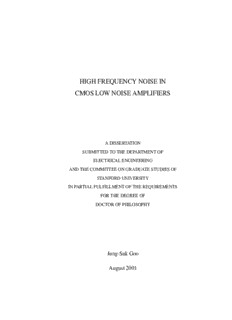Table Of ContentHIGH FREQUENCY NOISE IN
CMOS LOW NOISE AMPLIFIERS
A DISSERTATION
SUBMITTED TO THEDEPARTMENT OF
ELECTRICAL ENGINEERING
ANDTHE COMMITTEEON GRADUATE STUDIESOF
STANFORD UNIVERSITY
IN PARTIAL FULFILLMENTOF THEREQUIREMENTS
FORTHE DEGREE OF
DOCTOROF PHILOSOPHY
Jung-Suk Goo
August 2001
(cid:1)c Copyright by Jung-Suk Goo 2001
All Rights Reserved
ii
Icertify thatIhaveread thisdissertationand that inmyopinionitisfullyadequate,
inscopeand inquality,as adissertationforthedegreeofDoctorofPhilosophy.
Robert W. Dutton
(Principal Advisor)
Icertify thatIhaveread thisdissertationand that inmyopinionitisfullyadequate,
inscopeand inquality,as adissertationforthedegreeofDoctorofPhilosophy.
ThomasH. Lee
(AssociateAdvisor)
Icertify thatIhaveread thisdissertationand that inmyopinionitisfullyadequate,
inscopeand inquality,as adissertationforthedegreeofDoctorofPhilosophy.
ZhipingYu
ApprovedfortheUniversityCommitteeon GraduateStudies:
iii
iv
Abstract
T
HE IMPORTANCE OF CMOS TECHNOLOGY is increasing in RF design applica-
tions owing to the promise of integrating electronic systems on a single silicon
chip. Whilecompletebroad band characterization and accurate modelingof theMOSFET
noise are critical requirements for circuit designs, the noise behavior and physics in short
channel MOSFETs is not well understood. This dissertation explores the physical origin
and contributing mechanisms of noise in MOSFETs, as well as a design methodology to
minimizetheimpactofnoiseon fullyintegratedLNAs.
Investigatingthe physical noise sources in the MOSFET imposes significant computa-
tional requirements, due to the multi-dimensionalnature of the device. In addition, higher
order transport models need to be considered due to aggressive channel-length scaling.
This dissertation presents a quasi two-dimensional noise simulation technique which pro-
vides an accurate and fast solutionforMOSFET noiseanalysisby combininga 1-D active
transmissionlinemodelwithrigorous2-D devicesimulation.
The physical origin of the excess noise in short channel MOSFETs has been identi-
fied. Source-side contributions dominate drain current noise; non-local transport behavior
causes higher local ac resistance near the source junction and in turn generates extra noise
contributions which are amplified by the channel transconductance. This phenomenon is
directlyreflected inexcessvaluesandastronggatelengthdependenceofγ andδ inscaled
submicronMOSFETs. Higherorder transport modelsare essential to capturethis effect in
v
noisesimulation.
Contrary to the common assumption that drain current exhibits only 1/f and white
channel thermal noise contributions, this study demonstrates that the substrate generates
thermalfluctuationsthatproduceadditivechannelnoise,amplifiedbythesubstratetranscon-
ductance. Thiscomponentproducesanotherplateauandfrequencydependenceinthenoise
spectrumofthedrain current. Moreover,theeffect tendstoexaggeratethedrainnoisefac-
toratlowfrequencies.
The high frequency noise modeling for MOSFET devices generally requires at least
threeparameters. Thisstudydemonstratesthatwhileothertwo-parameterapproaches,such
as developed by Pospieszalski and those used in BSIM4 model, lead to errors, the results
do not cause noticeable discrepancies for most practical circuit topologies. The modeling
approach usedin BSIM4 has been independentlyvalidatedandis showntobesufficientin
capturingthephysicaloriginoftheexcessnoise.
Explicit guidelines for LNA design have been presented based directly on measured
noise parameters and two-port noise theory; the approach requires neither sophisticated
noisemodelingnorcircuitsimulation. An800MHzLNAtestchiphasbeendesignedbased
ontheproposedmethodology. With3.75mAofbiascurrent,theLNAachievesabout0.9dB
of noisefigure, which adds just0.3dB to the NF ofthe intrinsicMOSFET device. It is
min
competitivewiththatofGaAsandbipolarLNAsandalsoquiteclosetothevaluespredicted
usingtheanalysispresented inthiswork.
vi
Acknowledgments
I
WOULD like to thank many people who made my life at Stanford memorable and
enjoyable. Firstandforemost,Iwishtoacknowledgemyadvisor,ProfessorRobertW.
Dutton. He has been a great research mentor with his management skills and enthusiasm.
He also has been an exceptional role model of a senior of life. He has done his utmost
to help with every concern that his advisees have. I cannot forget how he encouraged and
supportedmewhileIwas lyingin bed forlongtimedueto aback injury.
Ialsowouldliketothankmyassociateadvisor,ProfessorThomasH.Lee,whogaveme
strongmotivationinmyresearch. IamindebtedtoDr. ZhipingYu,whoservedonmyoral
examandreadingcommitteesandwhoseincisivecommentswereagreathelpinnumerical
noise simulation tool development. I am also grateful for Professor John M. Cioffi, who
agreed to chairmyoral committeedespitehisbusyschedule.
ThestaffoftheCenterforIntegratedSystemshaveoffered goodsupport,andIwantto
thank Fely Barrera, Miho Nishi, Maria Perea, Carmen Miraflor, Maureen Rochford, Kate
Gibson, and Dr. Richard Dasher. I also want to acknowledgethe help of Greg Gorton, Ali
Tabatabaei,andHamidRateghwithCADtoolsontheJupiterproject. Special thanksgoto
Dr. Daniel Yergeau, whosecomputationalexpertisehas kepttheresearch in phase. Ithank
friends in the Stanford TCAD group for their helpful discussions and friendship: Chang-
Hoon Choi, Kwanghoon Oh, Tae-Young Oh, SoYoung Kim, Dr. Olof Tornblad, Xin-Yi
Zhang, Xiaoning Qi, Michael Kwong, Yi-Chang Lu, Atsushi Kawamoto, Choshu Ito, and
vii
Mr. HiroyukiSakai.
In addition to those in the Stanford community, I want to acknowledge a number of
industrial people who contributed directly to research. In particular, I would like to thank:
Dr. Tom Vrotsos, Dr. Keith R. Green, Dr. William Liu, and Mr. Donald J. Ladwig of
Texas Instruments for providing access to noise measurement equipment; Mr. Thomas
P. Redfern, Mr. Peter Hopper, Mr. Michael P. Schwartz, Mr. Robert Farmer, Dr. Hee-
TaeAhn,Mr. RichTaylor,andMs. LindaSmithofNationalSemiconductorforfabricating
chips,lendingwafers,andtestequipment;Dr. MarekMierzwinskiofAgilentTechnologies
and Professor Franc¸ois Danneville of University of Lille in France for collaboration in
noise simulation tool development; Dr. Conor Rafferty and Dr. Muhammad A. Alam of
AgereSystemsandProfessorSimonaDonatiofPolitecnicoDiTorinoinItalyforproviding
PADRE as well as cooperating in noisesimulation. I also want to thank several people for
providing noise measurement data: Dr. Alexander Rahm and Dr. Gerhard Knoblinger of
Infineon Technologies; Dr. Fariborz Assaderaghi and Dr. Lawrence Wagner of IBM; and
Professor Hiroshi Iwai of Tokyo Institute of Technology and Ms. Hisayo S. Momose and
Mr. Eiji Morifuji of Toshiba Corporation. I would like to acknowledge that this research
was initiated by the Defense Advanced Research Projects Agency and then supported by
TexasInstrumentsthroughcustomizedresearch ofSRC.
Finally, I must reserve special thanks for my significant others. I appreciate all the
friends: Yoon, Jung-Won, Youngmi, Wonil, Hyun Jin, Kern, Hyongsok, Jungsang, Nahm-
suk, Moon-Jung, Seong Taek, Dong-Hyun, Ki Young, Sang-Min, Jaewon, and folks in
Korea town in the basement of CIS. I would like thank my sisters – Hyun, Nan, Jung, and
Young – for their genial favor. I am deeply indebted to my mom in heaven and dad who
gave me unconditional support. I also want to thank my son, Timothy, for his hilarity that
refreshed mefromtheoverloadofresearch. Atlast,mysincerethanksarereservedformy
wife, Inseong, who has sacrificed her career for the family before and now begins a new
viii
studentlifeat Stanford.
Thiswork isdedicated tomy God.
ix
x
Description:vides an accurate and fast solution for MOSFET noise analysis by combining a 1-
D competitive with that of GaAs and bipolar LNAs and also quite close to the

